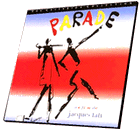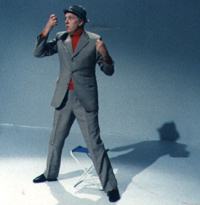

France comedy
1973
color 88 min.
Director: Jacques Tati
CLV: $49.95 - available
1 disc, catalog # CC1246L
VHS: available from Home Vision Cinema

It seems incredible that it's taken 17 years for a film as truly great as Parade -- Jacques Tati's final work -- to become available in the U.S., and that it's reaching the public, for the first time, on laserdisc. But old habits die hard, including our biases about technology as well as spectacle. Tati was the first major filmmaker to shoot a feature in video, and he brought to this challenge the same sort of innovative craft that he brought to the movies -- although the technical options available in video in 1973 were far from what they are today. He began by shooting with an audience at a circus in Sweden for three days, using four video cameras. Then, he spent 12 days in a studio reshooting portions of the stage acts on film.The first "gag" in Parade takes place in front of a theater and is so subtle it hardly qualifies as a gag at all. A teenager in line picks up a striped, cone-shaped road marker on the pavement and dons it like a dunce cap; his date laughs, finds another road marker, and does the same thing. In other words, the circus (or "parade") has already started before the audience enters the theater, fully apparent in the brightly colored, festive and flamboyant clothes worn by 1973 hippies in the audience as well as the props and toys carried by the toddlers.
The movie lingers over other preliminaries: people drifting to their seats, musicians tuning up, carpenters and painters (who later prove to be performers) working on props. The fact that these activities are as important as what follows dawns only gradually, in part because it becomes difficult to determine when and where the show does begin. When the opening trumpet fanfare is played by two clowns in the bleachers, many spectators are still arriving, and the camera seems so distracted by such details that we come to accept this fanfare and subsequent events as part of the preliminaries. Even when Tati himself strolls onstage as the official host and is greeted by applause, the camera abruptly sweeps past him to settle on the front rows of bleachers, where a little boy is clearly bored out of his wits, and a little girl, while applauding (along with her mother) in the row ahead, is looking at the boy, not at Tati. It is these two kids who improvise the movie's final sequence and true climax, after the official show is over.
Among the main acts are a number of Tati's most famous music-hall pantomimes, depicting a football game, a boxer, a fisherman, a tennis match, a tennis player circa 1900, and a horse-rider. Like Tati's directorial style, these mimes appeal to a spectator's imagination through a panoply of subtle suggestions. (Non-French speaking viewers have no reason to lament the absence of subtitles for Tati's introductions; they merely indicate the subjects of the routines, which are soon made self-evident.)
The physical borders of spectacle and audience are broken down through a variety of means. The painters and carpenters working onstage are frequently visible and even prominent as occasional spectators during some of the acts. An onstage row of fake bleachers containing black-and-white cutouts of spectators is integrated into some of the acts; this illusion is sabotaged in turn when real as well as fake spectators are later glimpsed in the same spot, or when fake as well as real spectators are glimpsed in the actual bleachers.
The ideas involved in this ideal family entertainment are at least as old as Brueghel's paintings, and one could state them as a series of simple maxims: there is no such thing as interruption or "backstage"; at no point does life and "the show" begin -- or vice versa; amateurs and nobodies -- that is to say, ordinary people -- are every bit as important, as interesting and as entertaining as professionals and stars; poetry always takes root in mundane yet unlikely places and it is taking place all around us, at every moment.
Tati's democratic aesthetics are more than just a matter of everything and everyone in a shot being worthy of close attention. They also function on a temporal plane -- every shot and moment is worthy of notice as well, and a moment without a fully articulated gag is not necessarily inferior to a moment with one, because the spectator's imagination is unleashed by the mere possibility that one might occur. Such tactics create a dispersal of focal points and privileged moments -- a utopian space where equality reigns between spectators and performers, children and adults, foreground and background, fiction and non-fiction, reality and imagination. The results are, simultaneously, an unpretentious diversion and a radical vision -- a politics of spectacle where, as in Tati's Playtime, the true hero is the audience and the true subject is everyday life.
-- JONATHAN ROSENBAUM
Credits
Director and Script: Jacques Tati
Presented by: Louis Dolivet
Production: Gray-Film, Sveriges Radio, CEPEC
Executive Producer: Karl Haskel
Associate Producer: Michel Chauvin
Scenery: Ulla Malmer-Lagerkvist
Costumes: Mona Forsen, Inger Pehrsson
Assistant Director: Marie-France Siegler
Directors of Photography: Jean Badal, Gunnar Fischer
Art Director: Jacques Larange
Music: Charles Dumont
Sound: Jean Neny
Editors: Sophie Tatischeff, Per Carlesson, Siv Lundgren, Jonny Mair, Aline Asseo
Transfer
This edition of Parade was transferred from a 35mm master print.




